Okay, let’s chat about one of the absolute coolest animals out there – the cheetah! Seriously, when you think “speed” in the animal world, this amazing big cat is probably the first thing that pops into your head, right? But honestly, there’s way more to the cheetah Acinonyx jubatus than just that famous sprint. Get ready to have your mind blown as we dive into 10 pretty incredible facts about these sleek, spotted predators.
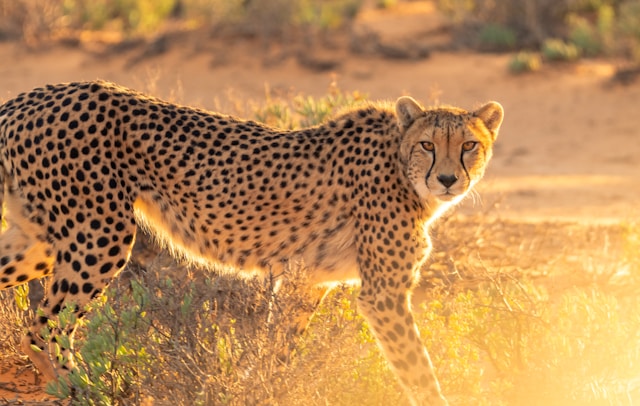
1. Yeah, They’re REALLY Fast
Alright, so this is the fact everyone knows, but trust me, it never gets less impressive. Just how fast can a cheetah actually run? Well, these wonders of evolution are, without a doubt, the fastest land animal on our planet. They can hit speeds of up to 60-70 miles per hour (that’s roughly 97-112 kilometers per hour!) in super short bursts. And get this – they can go from 0 to 60 mph in just three seconds. Seriously, that’s faster than a lot of sports cars! These unbelievable sprint speeds make them incredible hunters. We’re not just talking basic cheetah facts here; this is the stat that really defines them.
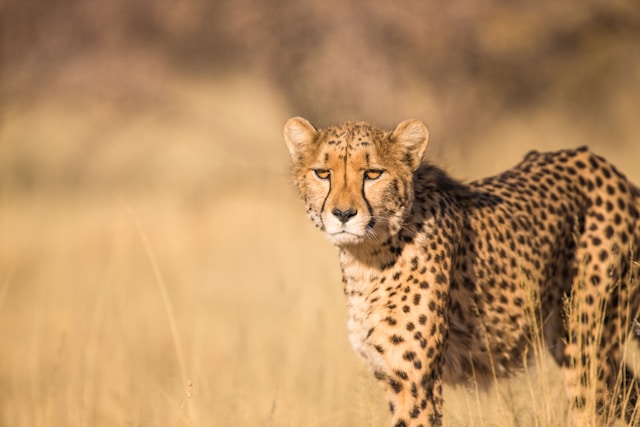
2. Built for Speed: Check Out These Adaptations
So, why are cheetahs so ridiculously fast? It really all comes down to some amazing evolutionary design. Their bodies are basically masterpieces built for high-speed chases. Some key cheetah adaptations include:
- A super lightweight, slender body with really long legs. You know, built lean.
- An incredibly flexible spine that pretty much acts like a spring, making their stride way longer.
- Big nasal passages, plus a large heart and lungs, all to get as much oxygen as possible during those intense sprints.
- Claws that don’t fully retract (semi non-retractable, fancy term!), which act kind of like running spikes for extra grip. Pretty neat, huh?
- A long, muscular tail that works like a rudder on a boat, helping them keep their balance and make sharp turns even when they’re flying.
Basically, every single part of a cheetah is fine-tuned for speed.

3. They’re Ambush Sprinters, Not Marathon Runners
Even though their speed is legendary, the way cheetahs hunt and use that speed is actually pretty strategic. They don’t really go for long, drawn-out chases that wear prey down. Nope. Instead, cheetahs use stealth to sneak up as close as they possibly can to their target (often getting within 100-300 feet) before unleashing that explosive burst of speed. The whole chase is usually over in less than a minute! If they don’t manage to make a kill quickly, they’ll often just give up the hunt. Why? Because those sprints take a ton of energy, so they need to conserve it. Their amazing speed is used tactically, maximizing that element of surprise.
So, what’s on the menu? Well, a cheetah’s diet usually focuses on medium-sized antelope – think gazelles (like Thomson’s or Grant’s), impalas, and springbok. They’ll also go for smaller stuff like hares and birds if the opportunity arises. What they eat really just depends on what’s available in their neck of the woods.
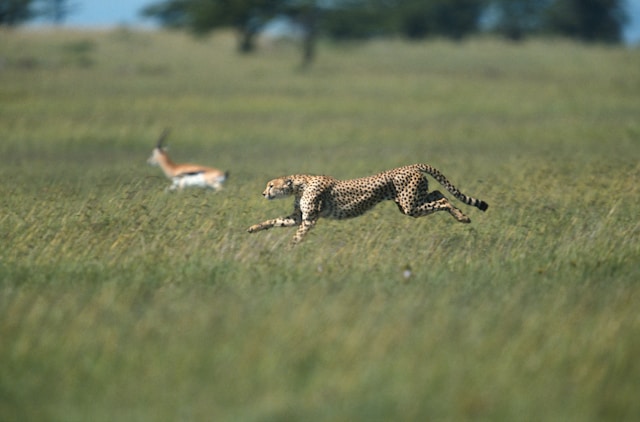
4. Where Do These Speedy Cats Live?
Thinking back, cheetahs used to roam all over Africa and even parts of Asia. Today, though, it’s a different story, and honestly, it’s pretty sad. Their habitat and range are much, much smaller and broken up. Most of the wild cheetahs left live in the grasslands and open woodlands of eastern and southern Africa – you know, classic African savannah territory. There’s also a tiny, critically endangered group of Asiatic cheetahs just barely hanging on in Iran. Their ideal home turf really needs wide-open spaces where they can properly stretch their legs and use that incredible speed.
5. Spot the Difference: Cheetah vs. Leopard
Okay, this is a common mix-up! People often confuse cheetahs with leopards, but believe me, they’re very different big cats. Here’s how you can tell them apart easily:
- Spots: Cheetahs have simple, solid black spots, kind of like polka dots. Leopards, on the other hand, have more complex spots called “rosettes” – they’re irregular shapes, often with lighter brown centers.
- Build: Cheetahs are built like sprinters – lean, long-legged, and slender. Leopards are stockier, way more muscular, and built for power and climbing trees.
- Face: This is a big giveaway! Cheetahs have those famous black “tear marks” running down from the inner corner of their eyes to the sides of their mouths. Leopards don’t have these lines at all.
- Claws: Remember those cheetah claws that don’t fully retract for grip? Well, leopard claws are fully retractable, just like your house cat’s.
See? Once you know what you’re looking for, telling them apart is actually pretty straightforward!
6. Living Life on the Edge
Now for some tough news. Sadly, the future for cheetahs is looking pretty uncertain. They’re listed as Vulnerable by the IUCN, and some specific groups (like those Asiatic cheetahs we mentioned) are Critically Endangered. The major threats pushing cheetahs towards the edge include:
- Losing their homes and having their habitats fragmented because of human expansion and farming. It really shrinks their roaming space.
- Conflicts with humans, which sadly often lead to cheetahs being killed by farmers trying to protect their livestock.
- A decrease in the animals they prey on. Less food makes survival harder.
- The illegal wildlife trade – things like poaching for their beautiful skins and capture for the exotic pet market. It’s heartbreaking.
- Really low genetic diversity within cheetah populations. This makes them much more vulnerable to diseases.
These incredible animals are definitely endangered species, and they really need our help.
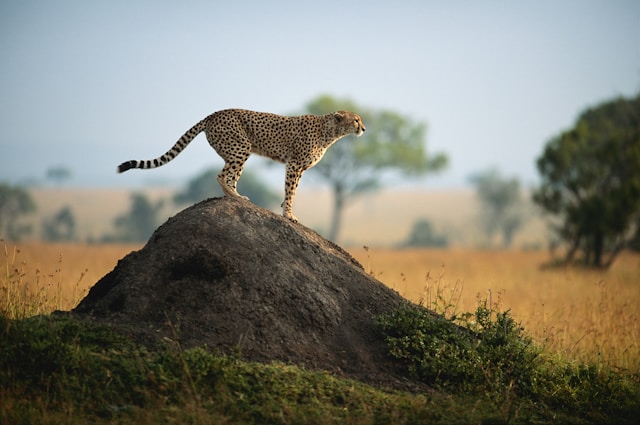
7. Racing Against Extinction: What’s Being Done?
Okay, but here’s the good news: there are tons of dedicated people and organizations out there fighting hard for cheetah survival. These conservation efforts for the cheetah population cover a lot of ground. They include things like:
- Protecting and trying to restore the habitats cheetahs need to thrive.
- Working closely with local communities to find ways to reduce conflicts between humans and wildlife (like using special livestock guarding dogs – cool, right?).
- Running anti-poaching patrols and fighting against the illegal wildlife trade.
- Lots of research and monitoring. This often involves tracking cheetahs to learn about their movement patterns and better understand what they need.
- Breeding programs in managed places like zoos and sanctuaries. These are super important for maintaining genetic diversity and could potentially help with reintroduction efforts back into the wild where it’s safe and possible. Protecting big cats like cheetahs really takes a global effort, and these wildlife preservation initiatives are absolutely crucial.
8. A Life Lived in the Fast Lane
Kind of reflecting their high-energy lifestyle, the average lifespan for cheetahs out in the wild is relatively short, usually around 10 to 12 years. If they’re in a protected environment like a sanctuary or zoo, they can live longer, sometimes reaching 17 years or even more. Life starts out tough, too. Cheetah cubs are born blind and totally helpless, and sadly, a lot of them don’t make it in the wild. They face dangers from predators like lions, hyenas, and even eagles, plus other environmental challenges. Mom cheetahs work incredibly hard to protect and raise their young, often moving them to new den sites frequently just to keep them hidden.
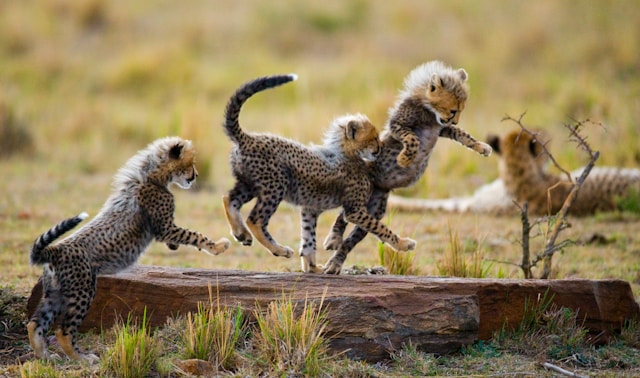
9. Super Important Players in Their Ecosystem
Cheetahs aren’t just fast; they play a really vital role in their environment. As predators, they help keep the populations of the animals they hunt in check. And guess what? That actually affects the plants too, by preventing too much grazing from happening. It all contributes to the overall health and balance of the savannahs and grasslands they call home. The role cheetahs play really shows you how interconnected everything in nature is.
10. Facing a Changing World
Just like so many other animals, cheetahs aren’t escaping the effects of the big environmental shifts happening worldwide. The impact of climate change on cheetahs is definitely something experts are concerned about. Changes in rainfall can mess with plant growth, which in turn affects where their prey hangs out and how many there are. More frequent droughts or crazy weather events can also directly impact whether cheetahs can survive and hunt successfully. Figuring out these impacts through ongoing research is super important so we can adapt conservation plans to help them. Maybe you’ve seen wildlife documentaries showing cheetahs facing these exact challenges? It’s a real issue.
So Much More Than Just Speed Demons
So, there you have it – 10 fascinating facts that give you a peek into the cheetah’s world. They’re clearly way more than just the fastest land animal; they’re highly specialized hunters, vulnerable icons of the wild places, and absolutely essential parts of their ecosystems. Their sheer grace, incredible speed, and unique adaptations make them truly captivating creatures.
But let’s be real, their future is kinda hanging in the balance. Supporting wildlife preservation efforts focused on cheetahs, learning more about the threats they face, and just spreading the word are all things we can do. It helps make sure these amazing animals can keep racing across the plains for generations to come. What fact about these awesome big cats surprised you the most?
